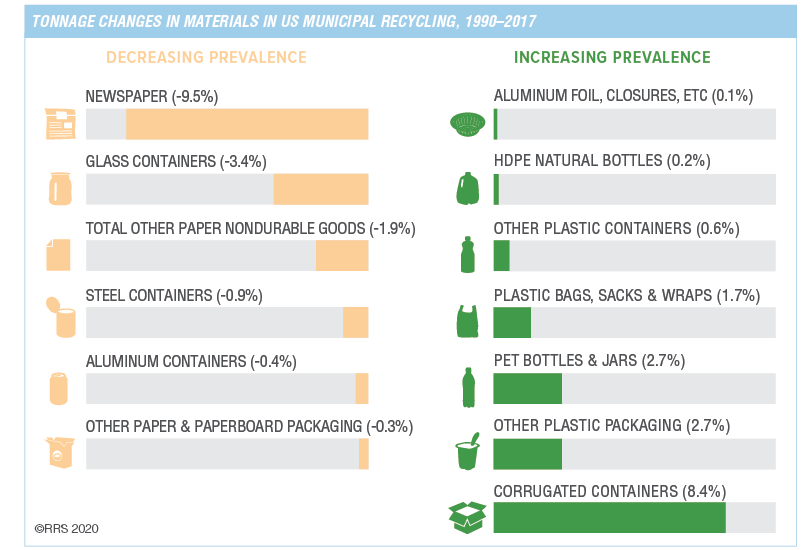Consumer-product packaging has evolved significantly over the past 25 years, challenging curbside recycling systems. In November 2019, the U.S. EPA released the annual national waste report, “Advancing Sustainable Materials Management: Facts and Figures.” RRS regularly analyzes data from this major source, as well as others, to track key trends by packaging category.
The chart below shows how tonnages of different categories of curbside materials have shifted from 1990 to 2017 (the most recent year for which numbers are available). Of note is the net sum increase of all plastic categories being larger than the net sum increase of all paper categories. Even though we see a significant increase in old corrugated containers (OCC) – not too surprising given the growth of e-commerce – this has been the only paper category that has increased in prevalence.
On the plastics side, the residential post-consumer flexible packaging stream includes bags, sacks and wraps, plus multi-layer pouches and bags (think granola, shredded cheese, chips, juice pouches and more). Analyzing data from the Flexible Packaging Association, the National Association for PET Container Resources, and the Association of Plastic Recyclers, approximately 12 billion pounds of this packaging category are sold each year – that’s twice the size of the PET bottle market.
The packaging sector’s push over the past 20 years to develop lighter-weight, dematerialized formats has helped reduce the carbon footprint of consumer packaging – both in manufacturing and transport – and helped reduce food waste. However, these formats are not generally recycled, even though research shows they can be used again for a variety of products. Pallets, roof sheathing, decking and rail ties are a few of the high-volume opportunities for these materials.
This massive quantity of flexible plastic packaging in commerce calls for two actions: plastic packaging value chain collaboration with the recycling industry and municipalities to adapt for sorting this packaging, and a pivot in procurement toward purchasing products that use less new material.
These actions will create demand for post-consumer recycled content products and produce a strong business case for updating recycling equipment to process today’s most prevalent packaging materials.

Source: RRS analysis of “Advancing Sustainable Materials Management 2017 Fact Sheet,” U.S. EPA, November 2019
This month’s Data Corner was produced by RRS. Learn more at recycle.com.
This article appeared in the June 2020 issue of Resource Recycling. Subscribe today for access to all print content.

